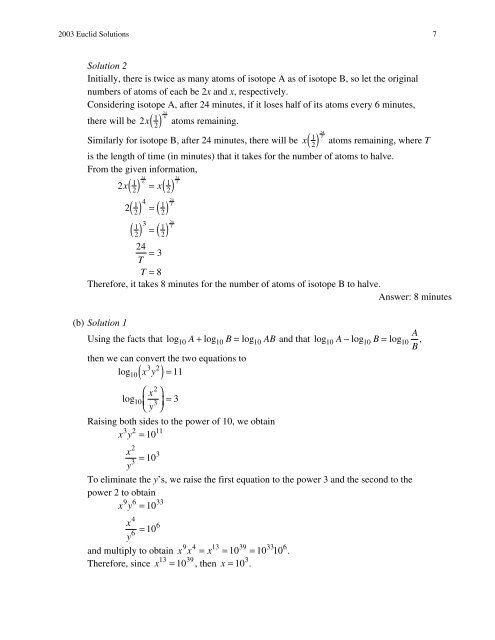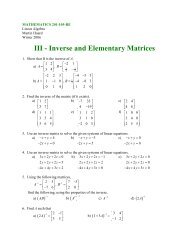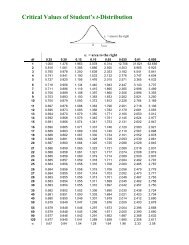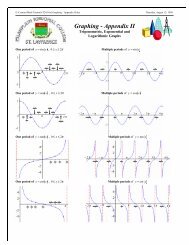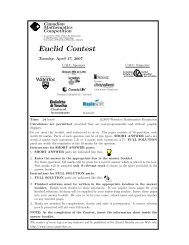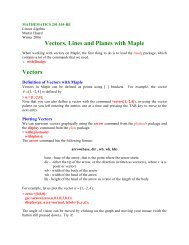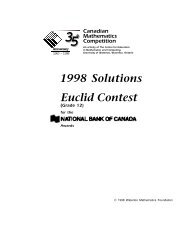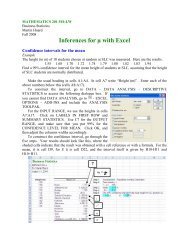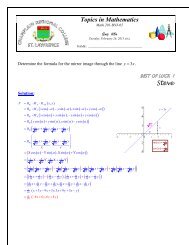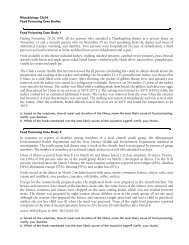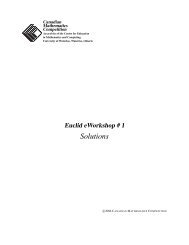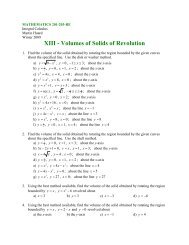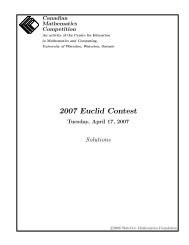<strong>2003</strong> <strong>Euclid</strong> <strong>Solutions</strong> 6This total still included some multiples <strong>of</strong> 10 that are less or equal to 300 (but not all,since we have already removed 30, for instance).In fact, there are 30 multiples <strong>of</strong> 10 less than or equal 300, 10 <strong>of</strong> which are multiples <strong>of</strong>15 as well (that is, the multiples <strong>of</strong> 30). So we must remove 20 from the total <strong>of</strong> 120.We then obtain that there are 100 positive integers less than or equal to 300 which aremultiples <strong>of</strong> 3 or 5, but not <strong>of</strong> 10 or 15.5. (a) Since the signs alternate every three terms, it makes sense to look at the terms in groups<strong>of</strong> 6.The sum <strong>of</strong> the first 6 terms is 1 + 3 + 5 −7 −9 − 11 = − 18.The sum <strong>of</strong> the next 6 terms is 13 + 15 + 17 −19 −21 − 23 = − 18.In fact, the sum <strong>of</strong> each group <strong>of</strong> 6 terms will be the same, since in each group, 12 hasbeen added to the numerical value <strong>of</strong> each term when compared to the previous group <strong>of</strong>6, so overall 12 has been added three times and subtracted three times.Since we are looking for the sum <strong>of</strong> the first 300 terms, then we are looking at 50 groups<strong>of</strong> 6 terms, so the sum must be 50( −18)=− 900.Answer: −900(b) Let the two digit integer have tens digit a and units digit b. Then the given informationtells us2 2a + 10b = b + 10a2 2a −b − 10a+ 10b= 0( a+b) ( a−b)−10( a−b)=0( a−b) ( a+ b−10)=0and so a = b or a+ b =10.So the possibilities for the integer are 11, 22, 33, 44, 55, 66, 77, 88, 99, 19, 28, 37, 46, 55,64, 73, 82, 91. We now must determine which integers in this list are prime.We can quickly reject all multiples <strong>of</strong> 11 bigger than 11 and all <strong>of</strong> the even integers, toreduce the list to 11, 19, 37, 73, 91.All <strong>of</strong> these are prime, except for 91 = 13 × 7.Therefore, the required integers are 11, 19, 37, and 73.6. (a) Solution 1In 24 minutes, the number <strong>of</strong> atoms <strong>of</strong> isotope A has halved 4 times, so the initial number<strong>of</strong> atoms is 2 4 = 16 times the number <strong>of</strong> atoms <strong>of</strong> isotope A at time 24 minutes.But there were initially half as many atoms <strong>of</strong> isotope B as <strong>of</strong> isotope B, so there was 8times the final number <strong>of</strong> atoms. Therefore, the number <strong>of</strong> atoms <strong>of</strong> isotope B halves 3times in the 24 minutes, so it takes 8 minutes for the number <strong>of</strong> atoms <strong>of</strong> isotope B tohalve.
<strong>2003</strong> <strong>Euclid</strong> <strong>Solutions</strong> 7Solution 2Initially, there is twice as many atoms <strong>of</strong> isotope A as <strong>of</strong> isotope B, so let the originalnumbers <strong>of</strong> atoms <strong>of</strong> each be 2x and x, respectively.Considering isotope A, after 24 minutes, if it loses half <strong>of</strong> its atoms every 6 minutes,there will be 21246x( ) atoms remaining.2241( ) atoms remaining, where TTSimilarly for isotope B, after 24 minutes, there will be x2is the length <strong>of</strong> time (in minutes) that it takes for the number <strong>of</strong> atoms to halve.From the given information,2x24246T( ) = x( )2121321212141( 2) = ( 2)( ) = ( )24T24T24= 3TT = 8Therefore, it takes 8 minutes for the number <strong>of</strong> atoms <strong>of</strong> isotope B to halve.Answer: 8 minutes(b) Solution 1AUsing the facts that log10 A+ log10 B= log10AB and that log10 A− log10 B= log10,Bthen we can convert the two equations to3 2log10( xy)=11⎛2x ⎞log10⎜3 ⎟ 3⎝ y ⎠=Raising both sides to the power <strong>of</strong> 10, we obtain3 2 11xy = 102x 33= 10yTo eliminate the y’s, we raise the first equation to the power 3 and the second to thepower 2 to obtain9 6 33x y = 104x 66= 10y9 4 13 39 33 6and multiply to obtain x x = x = 10 = 10 10 .13 39Therefore, since x = 10 , then x = 10 3 .


